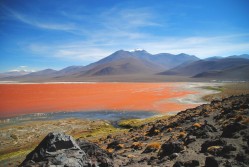
The main focus for most backpackers who travel to Bolivia is the Uyuni Salt Flats or Salar de Uyini, an otherworldly, reflecting plateau located in the High Andes in the southwestern part of the country.
When you book a salt flat tour in Bolivia, you don’t spend the entire duration of your travel in Bolivia’s strange southwest at the Uyuni Salt Flat — you explore literally hundreds of square miles of scenery that seems very out of place on Earth.

Regardless of which length of southwestern Bolivia tour you select, you begin your southwestern Bolivia travel in the dusty town of Uyuni, an industrial settlement about an hour by car from the Uyuni Salt Flats. There isn’t a lot to do in Uyuni, aside from booking your Uyuni Salt Flat tour, although friendly locals will be happy to converse with you if you speak even a little Spanish.

There it is: The Uyuni Salt Flats, probably the most popular attraction for backpackers who travel in Bolivia. After you reach the outermost expanse of the Uyuni Salt Flats, your jeep will drive to the so-called “Salt Hotel” in the middle of the Uyuni Salt Flats, where you and your group will be able to explore the salt flat on foot while your driver and/or guide prepare lunch. Contrary to popular legend, it isn’t possible to stay overnight in the salt hotel at the Uyuni Salt Flats. In fact, it’s illegal!

The so-called “Train Boneyard,” which is on the way back to the town of Uyuni from the Uyuni Salt Flats, is one of the eeriest sights you will see when you travel in Bolivia. That’s because this collection of defunct tracks and rusty engines is the vast majority of what remains of South America’s once-robust rail network.

I spent the first night of my Uyuni Salt Flat tour about three hours away from Uyuni in a no-name hostel somewhere in the middle of the southwestern Bolivian nothingness. You, too, will likely begin the second day of southwestern Bolivia travel with a stop at these lunar-looking rocks, which are surprisingly easy to climb, but about as far as you can get in aesthetic from the dreamy-looking Uyuni Salt Flats.

As my second day of travel in Bolivia’s southwest continued, it became clear that Southwestern Bolivia is a savage place, most certainly one unfit for human habitation. This is at once beautiful and discomforting: My tour jeep passed by two young women who were biking through this vast wilderness carrying only small backpacks. Indeed, even the native inhabitants of southwestern Bolivia aren’t always able to survive its harshness.

Thankfully, not all of the flamingos you encounter during my southwestern Bolivia travel are dead. The brick-red Laguna Colorada, whose color can be traced to the algae that live in it, is positively teeming with Andean flamingos, which I’ve been told are rare in spite of the fact that I saw literally thousands of them during my travel in Bolivia. Laguna Colorada is definitely one of the coolest places I’ve ever seen in my life.

As I’ve mentioned several times, you will travel by jeep on your Uyuni Salt Flat tour, but what I don’t think I have mentioned is just how much of your time will be spent in the jeep — conservatively, I would say about eight out of every 10 minutes. This isn’t completely surprisingly given the region’s aforementioned harshness, but I’d be lying if I said this perpetual confinement wasn’t among my least-favorite experiences during my travel in Bolivia.

If you are lucky — and I nearly wasn’t — you will cap off your travel in Bolivia (if you, like I, are heading to San Pedro de Atacama, Chile) with a dip in one of the several aguas termales natural hot springs that pepper the southwestern Bolivian landscape. The scalding, bubbly water will feel great not only because morning temperatures in southwestern Bolivia often hover around freezing, but also because you’ll be dirty, tired and probably even cranky after your Uyuni Salt Flat tour, in spite of the fact that it will no doubt be among the coolest things you’ve ever done.

Robert Schrader is a travel writer and photographer who’s been roaming the world independently since 2005, writing for publications such as “CNNGo” and “Shanghaiist” along the way. His blog, Leave Your Daily Hell, provides a mix of travel advice, destination guides and personal essays covering the more esoteric aspects of life as a traveler.








